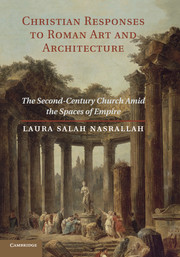 Christian Responses to Roman Art and Architecture
Christian Responses to Roman Art and Architecture Book contents
- Frontmatter
- Contents
- LIST OF FIGURES
- ACKNOWLEDGMENTS
- ABBREVIATIONS
- INTRODUCTION
- PART I FRAMING THE QUESTION, FRAMING THE WORLD
- PART II INTO THE CITIES
- 3 WHAT INFORMS THE GEOGRAPHICAL IMAGINATION? THE ACTS OF THE APOSTLES AND GREEK CITIES UNDER ROME
- 4 WHAT IS JUSTICE? WHAT IS PIETY? WHAT IS PAIDEIA? JUSTIN, THE FORUM OF TRAJAN IN ROME, AND A CRISIS OF MIMĒSIS
- PART III HUMAN BODIES AND THE IMAGE(S) OF GOD(S)
- EPILOGUE
- BIBLIOGRAPHY
- INDEX LOCORUM
- INDEX
- References
3 - WHAT INFORMS THE GEOGRAPHICAL IMAGINATION? THE ACTS OF THE APOSTLES AND GREEK CITIES UNDER ROME
from PART II - INTO THE CITIES
- Frontmatter
- Contents
- LIST OF FIGURES
- ACKNOWLEDGMENTS
- ABBREVIATIONS
- INTRODUCTION
- PART I FRAMING THE QUESTION, FRAMING THE WORLD
- PART II INTO THE CITIES
- 3 WHAT INFORMS THE GEOGRAPHICAL IMAGINATION? THE ACTS OF THE APOSTLES AND GREEK CITIES UNDER ROME
- 4 WHAT IS JUSTICE? WHAT IS PIETY? WHAT IS PAIDEIA? JUSTIN, THE FORUM OF TRAJAN IN ROME, AND A CRISIS OF MIMĒSIS
- PART III HUMAN BODIES AND THE IMAGE(S) OF GOD(S)
- EPILOGUE
- BIBLIOGRAPHY
- INDEX LOCORUM
- INDEX
- References
Summary
“This was not done in a corner,” asserts paul in the acts of the Apostles, speaking about the ideas and origins of his movement (Acts 26:26). In this brief sentence Luke's geographical imagination spills from Paul's mouth. Paul has just explained his own travel from Damascus to Jerusalem and throughout Judea and to the Gentiles, echoing Luke's understanding that “the Way” moves through the entire oikoumenē or inhabited world, eclipsing Jerusalem. And as he utters these words, Paul himself stands on the cusp of his final journey; after this he will be sent from Caesarea (where he had arrived from his Jerusalem imprisonment) to Rome. “This was not done in a corner.” Luke's economical assertion, placed in Paul's mouth, leads us to wonder: In the midst of Roman power and claims to possess the oikoumenē – claims manifest literarily and in the built environment – how did some early Christian communities imagine the space of the world? As we asked in the last chapter: What kind of geographical thinking did they engage?
Scholars have long noted that there is something peculiarly geographical about Luke-Acts. Luke refers to Christianity as “the Way” (ἡ ὁδός), and the canonical Acts' story of Christianity is restless and urban. Judea and Jerusalem were eclipsed in Justin's Dialogue with Trypho; in Acts, Christianity is propelled from the margins of empire and the center of Judaism, Jerusalem, to the center of the empire, Rome.
- Type
- Chapter
- Information
- Christian Responses to Roman Art and ArchitectureThe Second-Century Church amid the Spaces of Empire, pp. 87 - 118Publisher: Cambridge University PressPrint publication year: 2010


